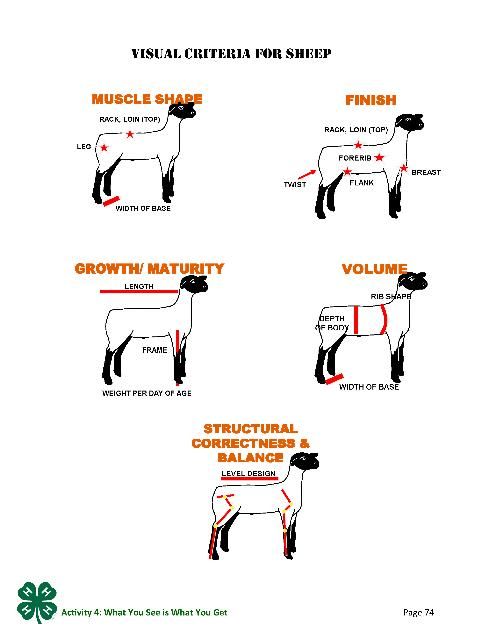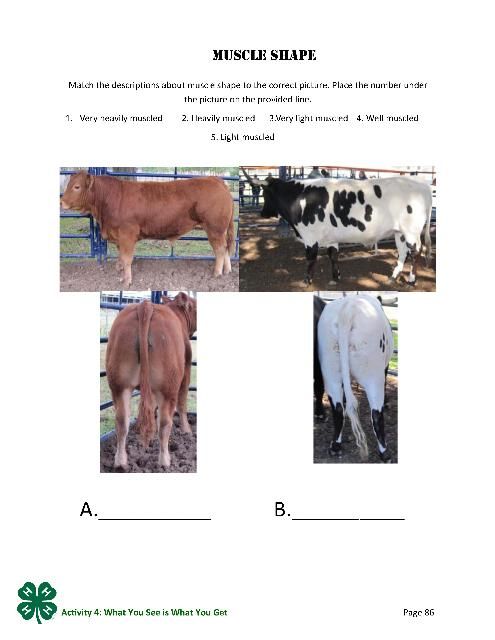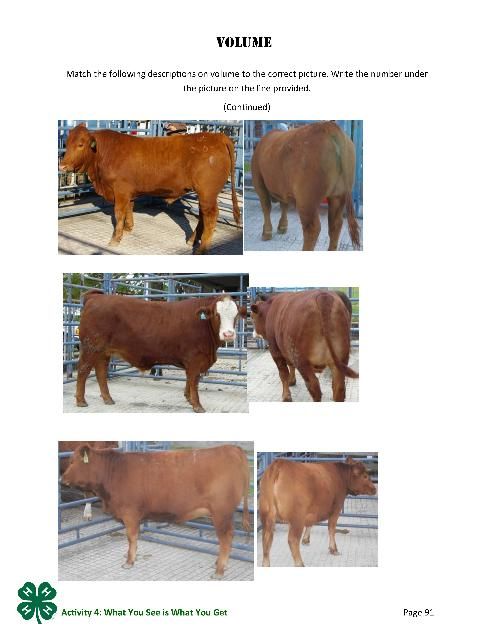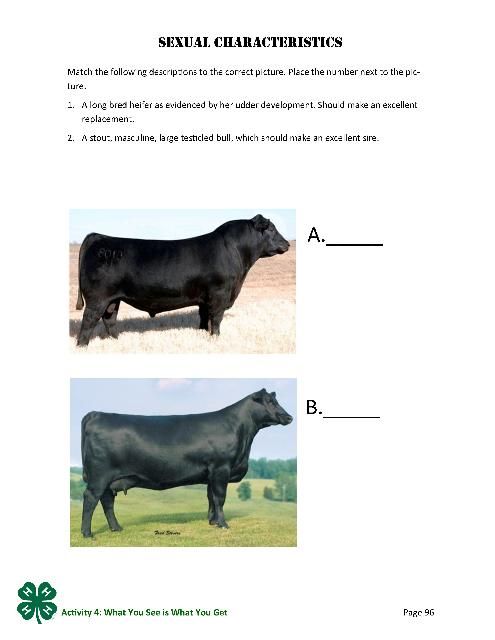4-H Livestock Judging: Activity 4, What You See Is What You Get!

Introduction
The process of visual appraisal and selection involves the weighing of good and bad points of the individual animal. The emphasis which is placed on each characteristic in visual selection depends on species, breed, sex, age and use. In many instances, more than one trait will be of top priority and you will have to weigh the relative worth of each trait in that animal.
You can learn a process to weigh the factors involved in decision making. This process can be beneficial whether you are judging animals, selecting clothing, choosing a college, or buying a car or a home. The first step is to set up priorities (already established for you in Criteria For Placing Using Visual Appraisal handout), and select based on those priorities. Today we will be doing an exercise to show you how to use this process in your appraisal of livestock.
DO
-
Have the youth make suggestions for the ideal characteristics and uses of a pencil. Examples: must have an eraser, dark lead, be #2 quality, sharpen easily, small, long, short, be able to fit in pocket/purse, not be damaged, be yellow, etc.
-
Using a flipchart or chalkboard, make a list of the suggestions.
-
Rank the traits listed in the order of most important to least important according to the group. The top traits are the priorities. Priorities, reasons, and uses are probably different from person to person.
-
Have youth justify their reasoning in a short statement.
-
Be prepared to select and buy only the pencil that fits the top criteria.
-
Repeat the exercise for a shirt and a car. Long/short sleeved, button down collar, pattern; on/off road, 4 wheel drive, CD player, etc.?
-
Hand out the CRITERIA FOR PLACING USING VISUAL APPRAISAL sheets and discuss the information with youth.
Reflect
-
How did the use of the objects effect your decision in selection?
-
How many of your priorities were from personal preference? From experience?
-
Did you realize that some of your original priorities weren't as important as others? (ex. pencil that has lead vs. NFL team logo)
-
Was it hard to compromise on your original priorities and select on need, rather than want?
-
Why is structure one of the most important traits in selecting a breeding animal?
Longevity.
-
When selecting a market animal, which trait is the most important?
The animal's potential carcass value, that is driven by muscling, fatness, and weight.
Apply
-
Set up a field trip to a ranch, livestock market, farm or fair. Do not set up a class of animals, but have the group single out animals and discuss their positive and negative traits. Be sure to include information on the animals' use, structural soundness, potential carcass value, reproductive potential, and balance.
-
When judging livestock it is crucial that you have a mental picture of the ideal animal for the species. By keeping the ideal in mind, you will be able to notice individual flaws rather easy. Using the Internet, research and study several of the on-line virtual judging sites for learning to recognize the ideal animals by species.
Criteria for Placing
Using Visual Appraisal
These criteria are only guidelines and vary with market demand, breed, age, management scenario, and performance data.
Swine
Market Hogs
Muscling
Leaness/maturity
Growth
Production Traits
Both
Growth/Maturity
Structural soundess
Muscling
Breeding Hogs
Sexual characteristics
Volume
Sheep
Market Lambs
Muscling
Correctness of finish/maturity
Balance
Production Traits
Both
Growth/Maturity
Structural soundess
Muscling
Balance
Breeding Sheep
Sexual characteristics
Volume
Cattle
Market Steers
Muscling
Correctness of finish/maturity
Balance
Production Traits
Both
Growth/Maturity
Structural soundess
Muscling
Balance
Breeding Cattle
Sexual characteristics
Volume
Answer Keys to Visual Criteria Practice Worksheets
Swine
Muscling
A: 4—Very Light muscled
B: 1—Heavily muscled
C: 3—Light muscled
D: 2—Well muscled
Leanness
A: 3—Acceptable leanness—approximately 0.9" at 10th rib
B: 4—Fat—approximately 1.1" at 10th rib
C: 5—Very Fat—approximately 1.3" at 10th rib
D: 1—Very acceptable leanness—approximately 0.6" at 10th rib
E: 2—Very acceptable leanness—approximately 0.7" at 10th rib
Growth/Maturity
A: 1—Fast growing, but short, low set, and early maturing
B: 2—Fast growing and relatively late maturing
C: 3– Slow growing, frail featured, and early maturing
D: 4—Late maturing and very slow growing
Volume
A: 1—Bold ribbed, deep bodied, wide tracking
B: 2—Relatively flat ribbed, shallow flanked, and wide tracking
C: 3 – Bold ribbed and wide tracking
D: 4—Very flat ribbed, shallow flanked, and narrow tracking
E: 5—Relatively bold ribbed, deep bodied, and wide tracking
Soundness
A: 5— A very poor designed, straight shouldered, straight kneed, and short hipped market hog
B: 3— A well designed, level, and square made market hog with correct joint angulation to both ends of the skeleton
C: 1—A poor designed, straight shouldered, straight kneed, short hipped market hog
D: 2—A well designed, level, and square made market hog which is a bit straight though the shoulder and knee
Sexual Characteristics
Underlines
A: 3—-Good underline, good spacing, good teat quality
B:2—Poor spacing, too far between first and second teat, good teat quality
C: 1—Poor teat quality, too blunt, second teat would be considered "pin" nipple
Vulva
A: 1—Normal vulva
B: 2—Tipped vulva
C: 3—Infantile (small) vulva
D: 4—Swollen vulva
Design
A: 3—Her ill design and inadequate body volume and terminal appearance suggest she should not be kept as a replacement.
B: 2—Her ill design, inadequate body volume, and small vulva suggest she should not be kept as a replacement
C: 1—Her design, body type, and external sexual characteristics suggest she should be a desirable brood sow prospect.
Sheep
Muscling
A: 4—Relatively light muscled
B: 2—Very heavily muscled
C: 3—Well muscled
D: 1—Very light muscled
Finish for Sheep
A: 1—A correctly finished lamb with 0.15-0.20" of fat thickness
B: 2—A very over finished lamb with 0.35-0.40" of fat thickness
Growth/Maturity
A: 3—Relatively fast growing, but early maturing
B: 1—Growthy, upstanding, and late maturing
C: 2—Upstanding and late maturing—though probably not as fast growing as some
D: 4—Relatively fast growing, but early maturing
Volume
A: 2—Flat ribbed, shallow bodied, and low volumed
B: 3—Relatively bold ribbed, deep flanked, and high volumed
C: 1—Bold ribbed, deep flanked, and high volumed
D: 4—Tight ribbed, and very shallow flanked–appears to be low performing
Structural Correctness
A: 1—A wether which is too straight and forward in his shoulder, short and round out of his dock, and weak in his pasterns
B: 3—A very level ewe who appears to have the correct angulation to all her joints, and should move correctly when put into motion
C: 4—A ewe, who appears to have the correct angulation to all her joints, and should move correctly when put into motion
D: 2 –A very level, square made wether with his feet on all four corners. He does appear to bow out on his rear legs
Balance
A: 4—An extended, square made, high volumed ewe
B: 2—A square made, high volumed ewe. She is too coarse and deep in her shoulder and breast, decreasing her balance.
C: 3—A long bodied ewe that rounds out of her dock, easy in her top, somewhat u-necked and deep-breasted, decreasing her balance.
D: 1—Straight lined, upstanding, well balanced ewe. She is a bit short bodied.
Sexual Characteristics
A: 1—Long bred ewe as evidenced by her udder development, should make an excellent replacement.
B: 2—A stout , masculine, large testicled ram with proper testicle carriage, should make an excellent sire.
C: 3—A small testicled ram whose testicles are carried too close to his body, potentially affecting his fertility.
Cattle
Muscling
A: 1—Very heavily muscled
B: 3—Very light muscled
C: 2—Heavily muscled
D: 4—Well muscled
E: 5—Light muscled
Correctness of Finish
A: 3—Very over finished— approximately 1.0" of fat thickness
B: 2—Very under finished—approximately 0.10" of fat thickness
C: 1—Correctly finished—approximately 0.45" of fat thickness
D: 4—Slightly over finished— approximately 0.65" of fat thickness
E: 5—Underfinished—approximately 0.25" of fat thickness
Balance
A: 3—Very poor balanced
B: 1—Well balanced
C: 2—Poor balanced
Growth/Maturity
A: 3—Stout made, high growth steer
B: 1—Small framed and probably rather slow growing
C: 2—A steer intermediate for growth and finished weight
Volume
A: 5—A flat ribbed, shallow bodied, low volumed steer
B: 2—A bold sprung, deep bodied, high volumed steer
C: 4—A steer with an excellent, square rib shape, which needs more depth from forerib to flank
D: 3—A deep bodied steer, which needs more rib/body shape
D: 1—A bold sprung, deep bodied, high volumed heifer
Structural Correctness
A: 1—A square made, level steer, who needs more angulation to his shoulder and more set to his hock and pastern
B: 3—A slightly round made steer that appears to have the correct angulation to all of his joints, and should move correctly when put into motion
C: 2—A straight shouldered, short hipped steer who is very straight in his hocks
D: 4—A relatively square made steer that appears to have the correct angulation to all of his joints, and should move correctly when put into motion.
E: 5—A very short, round hipped steer who has excess set to his hock (sickle hocked)
Sexual Characteristics
A: 2—Stout, masculine, large testicled bull
B: 1—Long bred heifer as evidenced by her udder development
Visual Criteria for Swine











Visual Criteria for Sheep











Visual Criteria for Cattle
















